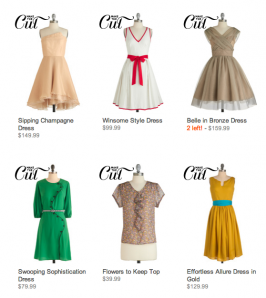For a long time, Americans thought nothing of ordering up clothes by looking at pictures and reading descriptions without handling those clothes first, and the Sears catalog was a cultural touchstone for many. The advent of the car and modern shopping mall might have changed this, but a group of online retailers are going back to retro marketing principles with online-only clothing brands, taking advantage of digital storefronts to provide cheaper, high-quality products.
There are certainly hurdles for these companies to overcome. New fashion lines have to build customer loyalty and name recognition just as any new brand would, and they have to figure out how to scale the business without the benefit of physical stores and traditional window shopping. But if online fashion brands can build loyalty and figure out how to scale the company, they have some advantages the physical stores do not. They can eliminate mark-ups that come from selling to boutiques or distant stores, sell similar-quality products only slightly above wholesale prices, and offer a larger inventory because they don’t have to worry about stocking lots of shelves.
Looking to build your digital fashion brand? Here are a few idea worth considering:
Crowd-source your styles

ModCloth lets customers vote on the styles they want to see.
Kickstarter has popularized the idea of allowing customers to vote on a future product, and this has proved equally popular in digital fashion. Women’s fashion brand Modcloth recently released a collection of dresses that were designed and selected by the company’s fans on Facebook. California-based StyleSaint raised $1.5 million in funding from Andreesen Horowitz and others to turn blogger-created “stylebooks” into crowd-sourced fashion lines. And children’s clothing company One Jackson raised a $2 million seed round earlier this month and launched last week to allow parents to vote on styles they want for their kids.
What’s the benefit of letting people design their own clothes? One Jackson co-founder and CEO Anne Raimondi said they’ve seen parents picking styles for production that most children’s designers wouldn’t necessarily do on their own.
“It’s not the bright primaries or pastels you see everywhere else,” she said. “We’ve found that people like really rich colors. People like grown-up colors in kids sizes.”
Focus on word-of-mouth marketing
Both a positive and negative aspect of online-only brands is their feeling of exclusivity — you probably won’t see their signs at the local mall or their ads at the bus stop. Bayard Winthrop, founder and CEO of the San Francisco-based menswear company American-Giant, said this means a huge part of building a fashion brand is creating word-of-mouth buzz. Obvious, but critically important, he said.
“Our relationships with brands is moving from what used to be a broadcast experience to a much more personal brand-building relationship,” Winthrop said. “The friend they tell about the brand suddenly has heard of it and becomes a customer. I think brands are actually getting built differently these days, and gaining credibility through word of mouth and one to one relationships.”
Provide an in-person experience

Everlane’s billboard in NYC.
While many of these stores save money and have built their brand around the idea of digital-first, finding a way to give customers an in-person glimpse of the products can make for good marketing. Mens fashion line J. Hilburn has “style advisors” located around the country to help customers shop and measure for styles, and over 95 percent of customers take advantage of this feature, said company representatives. And Everlane, the San Francisco-based tshirt and accessory company, put up a billboard in Manhattan and held a promotional “pop-up” event in SoHo in New York for several days, allowing customers to feel some items before purchasing them for home delivery.
“It’s still the biggest challenge we face,” said Everlane CEO and co-founder Michael Preysman, of getting people to purchase their clothes online.
Sell less

American-Giant sells only three tshirt designs for men.
It’s certainly not the ethos of online retailers like Amazon or Zappos, but selling fewer items is definitely a tactic individual retailers like American-Giant or Everlane have adopted. Everlane sells only three t-shirt styles for women, and American-Giant sells only only three t-shirt designs for men. The decision to go minimalist and create a boutique experience on the web was intentional, Preysman said.
“By going one piece at a time, you can focus on buiding that quality experience,” he said, noting that if Everlane had to stock physical shelves, they might have to produce more than three t-shirt styles. “When you know what you want to buy, and you can measure it with megapixels or memory… it’s really easy to buy online because you can compare specs and know it’s the best product. But anything with an emotional-based experience, it’s harder for the web to satisfy those. Which is why we go toward the minimalist experience, because that’s how people really want to shop. With a curated selection of items.”